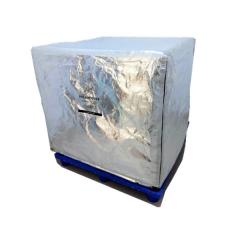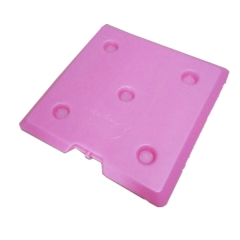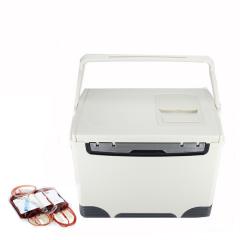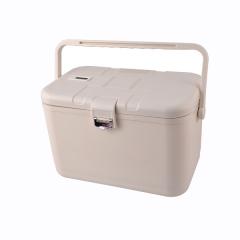When UNICEF sends vaccines, they always travel directly by plane from the manufacturer as refrigerated cargo to the country where they will be used. Once they land, they are stored in cold rooms before being distributed to regional and sub-regional cold storage facilities by refrigerated vehicles. From storage facilities down to the village level, health workers carry vaccines in cold boxes and vaccine carriers, travelling by car, motorcycle, bicycle, donkey, camel or on foot to immunize every last child, even in the most remote of villages.
Storage and transport equipment such as cold rooms, refrigerators, freezers, cold boxes and vaccine carriers must comply with performance standards defined by the World Health Organization (WHO). Stock management procedures must also follow WHO guidelines specific to each type of vaccine.
UNICEF procured US$105.9 million worth of cold chain equipment and services in 2023. We work closely with partners and governments to ensure the cold chain continues to work effectively and efficiently in every country where we deliver vaccines to children.
What is WHO/PQS and how do I know if the equipment is PQS pre-qualified?
UNICEF SD only procures WHO pre-qualified equipment, listed in the WHO PQS (Performance, Quality and Safety) manual, which is being updated on a continual basis. The WHO PQS Catalogue is accessible online.
How do I find out what is the electric supply voltage in my country i.e. the single phase, three phase and frequency?
Power supply for cold chain equipment is supplied by the national grid or by a generator. When in doubt, contact the national power supply company. The power supply can either be 220-240V single phase or 380-400V 3-phase. In some countries (e.g. USA) the voltage is 120V single phase and 210V 3-phase. The frequency is either 50 or 60 Hz.
How do I determine the size of refrigerators to procure?
The decision to acquire additional cold chain equipment should be based on several criteria, most important of which are the current existing storage capacities for vaccines and the anticipated future storage requirements. Acquiring refrigeration equipment calls for the involvement of EPI managers and logisticians to determine required storage capacities.
Walk-In cold rooms and freezer rooms
What are the points to consider when thinking of installing cold rooms?
Points to consider include:
- Dimensions and power consumption,
- Who will do the installation,
- Site readiness for installation,
- Temperature monitoring,
- Alarm system,
- The need for a generator,
- The need for a voltage stabilizer,
- Spare parts, and
- Training for users and technicians.
Refer to the WIC/WIF Product Guideline for more details.
We want to order a cold room but don't know how to install it. Can UNICEF Supply Division (SD) help us with this?
Yes, UNICEF SD can assist, but it is important that they are notified as early as possible. This will help minimize the risk of potential bottlenecks, in particular relating to the availability of external technicians and practical preparations.
Will we need special training for maintenance of cold rooms?
Staff need to be trained in using and maintaining the equipment correctly and confidently. The training will include routine and preventive maintenance, such as temperature monitoring, cleaning of the rooms and fault reporting.
What is the difference between split system and plug-in system?
A plug-in system has the controls, the compressor, the condenser and the evaporator as one complete unit, assembled and ready for installation. The split system consists of two main parts:
- the condensing component for installation outside the room where the WIC/WIF is installed, and
- the evaporator component installed inside the Cold Room.
We need to order a large cold room outside the size range shown in the web catalogue. Can this be done?
Yes. UNICEF SD can assist with the supply of non-standard sized rooms. However, non-standard sized WICs/WIFs may require an additional 2-3 months for procurement.
How long will it take to assemble a cold room so it is ready to be commissioned?
The actual assembly time will depend on technical capacity available, but typically takes a few days. To avoid delays it is important that the site is ready for the installation, before the equipment arrives on site. That includes the provision of electric power and switches.
Refrigerators and freezers (non-solar)
What are absorption type refrigerators?
Absorption refrigerators use heat rather than electricity as their energy source. An absorption refrigerator makes use of some type of heat source to create the energy that operates the cooling system. Refrigerators of this type often use kerosene, but gas or other heat sources may also be used.
Does UNICEF SD still supply absorption type refrigerators?
UNICEF SD no longer recommends their procurement. Solar powered systems may prove to be the most viable alternative. Absorption refrigerators are poor in efficiency, while it proves difficult to control the temperature within the recommended parameters. Moreover, kerosene absorption refrigerators are environmentally unfriendly and contribute to global warming.
Solar powered refrigerators and freezers
What is the difference between battery powered solar refrigerators and solar direct drive (SDD) refrigerators?
Battery powered solar refrigerators use a battery bank to store the energy from the sun. SDD systems do not have such a battery; the energy is stored using different non-battery based technologies. Because batteries are often the main cause for system failure, the higher cost of SDD systems may be justified.
How do we know the right place to put the solar array?
Site selection based on historical meteorological weather data is essential for the successful performance of the solar powered systems. Devices are available to optimize the angle of the solar arrays based on annual sunshine data.
Are there any special requirements needed for installing a SDD System?
Yes. Make sure that:
- Local staff are available with suitable qualifications,
- Installation site is ready for the installation, both for the equipment and the solar arrays, and
- Someone on the customer side can always be contacted for enquiries.
We already have solar panels from an old system can these be reused with the SDDs?
This is not recommended. SDD systems procured through UNICEF SD are normally shipped complete with properly sized solar arrays. Also bear in mind the finite lifetime of solar panels and the fact that they gradually produce less power as they age.
How are solar panels best maintained to ensure they give optimum performance?
Dirt or other debris on the panel faces will block sunlight and reduce the energy output of the panels. The most frequent maintenance need for solar arrays will be the cleaning of the panel faces.
What about temperature monitoring for solar powered systems?
Solar powered systems need temperature monitoring, just like other cold chain equipment in the EPI programme.
What happens when there is no sun?
Solar powered systems are designed in such a way that they continue to function for several days when there is no sun. ‘Autonomy’ is the number of days that the refrigerator maintains the acceptable temperature range under low sunshine conditions.
Can I run other electrical items such as lights or a radio off the solar panels?
No. Tapping power for other accessories such as radios and lights from the battery pack is not allowed, as it will affect the proper functioning of the solar powered system.
Temperature monitoring devices
What type of temperature monitoring device shall I use for a specific purpose?
The WHO PQS gives guidance to available pre-qualified temperature monitoring solutions. A distinction is made for temperature monitoring devices for
- cold rooms and freezer rooms: central temperature monitoring system, programmable electronic temperature and event logger systems and pen chart recorders,
- refrigerators and freezers: data loggers and dial thermometers, and
- transportation in cold boxes and vaccine carriers: electronic freeze indicators, cold chain monitor, vaccine vial monitor and electronic shipping indicator.
Vaccine carriers, cold boxes and ice packs
When and where do I use vaccine carriers and cold boxes?
Vaccine carriers are insulated containers that, when lined with coolant packs, keep vaccines and diluents cold during transportation. They are smaller than cold boxes and are easier to carry when walking. They are used for transporting vaccines from health facilities with refrigeration to outreach sessions where refrigeration and ice are not available. Cold boxes are used to collect and transport vaccine supplies from one fixed vaccine store to another, and from vaccine stores to health facilities. They are also used to temporarily store vaccines when the refrigerator is out of order or being defrosted.
How many ice packs do I need for a vaccine carrier or cold box?
Coolant packs (often called ice packs) are flat, square plastic bottles that are filled with water and cooled. The number of coolant packs required for a cold box or vaccine carrier varies according to the type of cold box or vaccine carriers. Coolant packs are available in 0.3, 0.4 and 0.5 litre capacity.
Voltage regulators and stabilizers
When should I use a voltage regulator or stabilizer?
WHO recommends that wherever supply voltage fluctuations exceed seven per cent of the nominal voltage, up or down, regulators or stabilizers should be used. This applies to all cold chain equipment in the EPI programme.
What is the difference between a voltage regulator and a voltage stabilizer?
Generally speaking, voltage regulators are small and portable, suitable for refrigerators and freezers, while stabilizers are larger and used for cold rooms and freezer rooms.
Should I order single phase or three-phase voltage regulators and stabilizers?
That depends on the equipment that you want to protect. Smaller appliances such as refrigerators work on a single-phase voltage regulator, while a three-phase voltage stabilizer is normally used for cold rooms and freezer rooms.

 magyar
magyar  English
English français
français русский
русский italiano
italiano español
español português
português العربية
العربية 日本語
日本語 한국의
한국의










